Table of contents
- Restoration of the BMW R 80 G / S Part 1, engine
- Rust and verdigris on every nook and cranny
- The pleasure of screwing
- Will that last??
- The camshaft timing chain including the slide rail renewed
- Trying out: ice blasting device
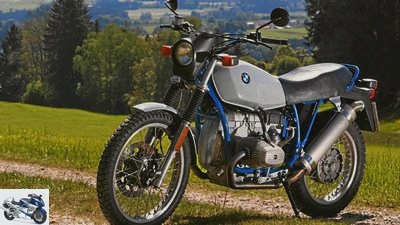
Cook

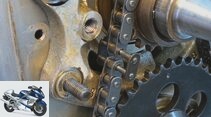
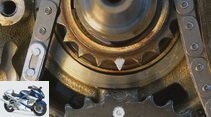
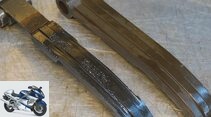
21 pictures
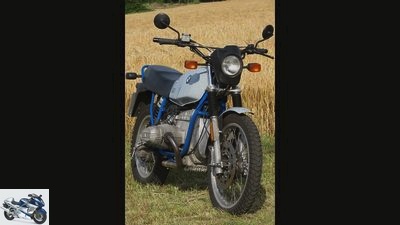
Cook
1/21
The good news first: It’s working. Velvety soft, with an impeccable chassis and really amazing qualities. A classic for every day that makes you even more cheerful with every kilometer.
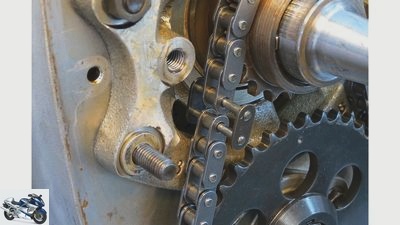
Cook
2/21
The big fiddling: Bring the engine in a slightly forward inclined position (upright the chain lock can fall through the opening in the crankcase), align the camshaft and crankshaft. Then the old chain lock is threaded into the chain from the front and thus creates the appropriate distance between the rollers. Then the new lock is inserted from behind using small needle-nose pliers or a flexible magnet. Then attach the chain link and fuse – done.
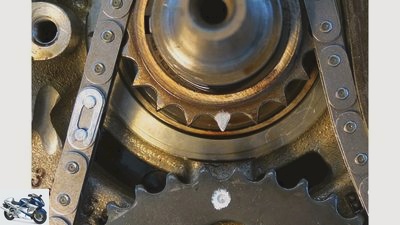
Cook
3/21
Mount the chain retainer / clip with the closed side in the direction of travel. Remove the cable tie on the tensioner, turn the motor several revolutions in the running direction and then check the setting marks.
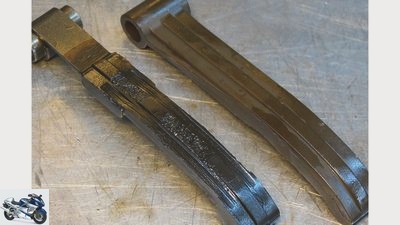
Cook
4/21
The old slide rail of the timing chain tensioner (left) made of a sheet steel / plastic composite with clear tracks and breakouts from the porous running surface was replaced by a new, one-piece plastic component.
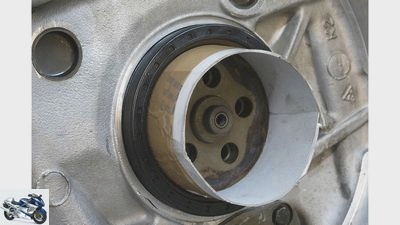
Cook
5/21
The large oil seal on the crankshaft must be lifted over the shoulder on the crankshaft stub with a thin sleeve, in this case a temporary construction made of cardboard and adhesive tape.
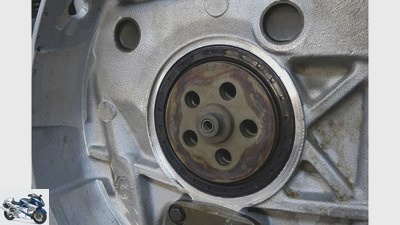
Cook
6/21
Only when the sealing lip sits on the actual crankshaft journal can the Simmerring be evenly pressed in. The blind plugs (arrow) are protected from corrosion with clear varnish.
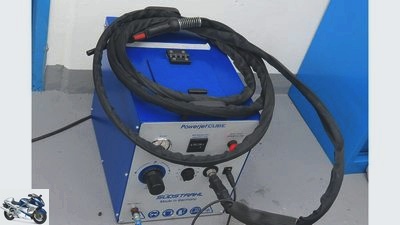
Cook
7/21
Compact ice blasting device with hose package that is filled with dry ice granulate.
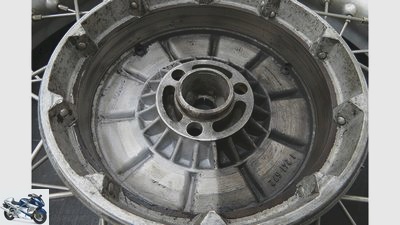
Cook
8/21
The stubborn brake dust was removed from the BMW drum brake without damaging the brake ring.
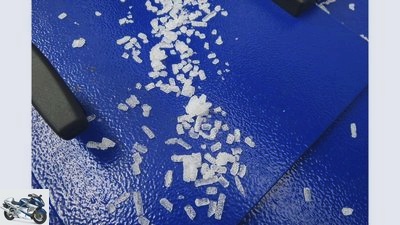
Cook
9/21
The cleaning went perfectly.
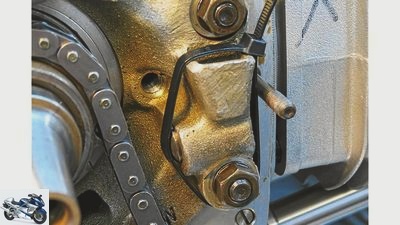
Cook
10/21
Since the piston of the chain tensioner has to be mounted in front of the new timing chain, it can be fixed with cable ties in order to mount the slide rail and the chain lock without tension.
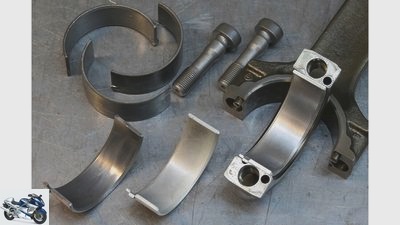
Cook
11/21
If so, because already: The old connecting rod bearings (left) with the smeared sliding surfaces and the screws on the connecting rod base have been replaced by new ones (right). The surface of the crank pin and crank pin was in perfect condition, free from scratches.

Cook
12/21
The piston rings are pressed together with a tension band (right). We swapped the assembly steps, first maneuvered the piston into the cylinder with a tightening strap and then threaded the piston pin.

Cook
13/21
Winter 2013: the matt black whitewashed 80 G / S before complete dismantling.
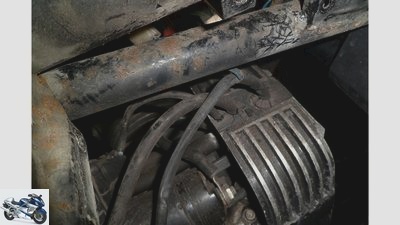
Cook
14/21
The cables to the electric starter run through rubber grommets, which are cracked and brittle and immediately put on the shopping list. Pay attention to the original routing and position here as well.
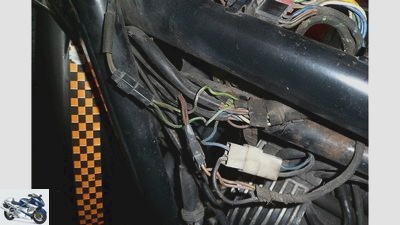
Cook
15/21
This photo documents the laying of the cable harness under the tank and the plug connections. The textile covering has suffered a lot and has to be rewound.
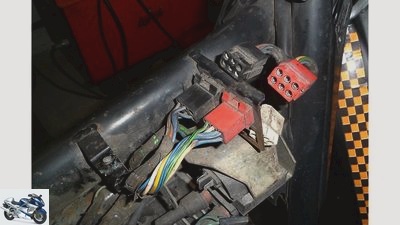
Cook
16/21
The same applies to these multiple plugs, which are corroded on the contact surfaces. Thorough cleaning with MoS2, a brass brush and cotton swab helps here.

Cook
17/21
With two screw clamps and a square tube, the engine block, blasted with glass beads, is clamped onto a wooden board for dismantling and dismantled step by step.
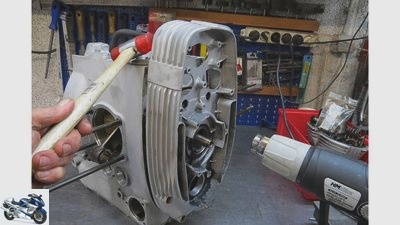
Cook
18/21
To dismantle the front engine cover, it is heated to around 100 degrees and removed from the shrunk-on roller bearings by tapping gently with a plastic hammer, without tilting.
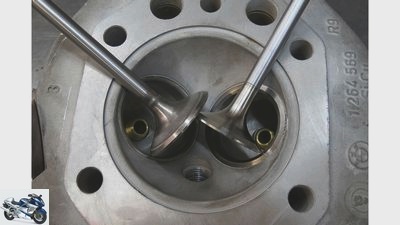
Cook
19/21
The cylinder heads have been completely renovated by a specialist. New guides with less clearance, seats in lead-free quality and new valves that have been smoothed in the area of the valve disks. Transitions between seat and canal can be leveled.
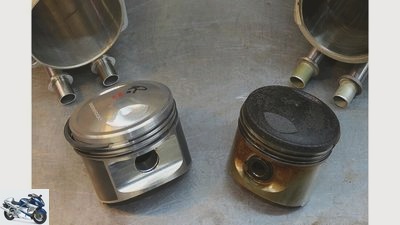
Cook
20/21
On the left the new power kit piston with graphitized piston skirt, on the right the original with 114,000 kilometers under its belt and clear traces of fire on the piston skirt. One of the reasons for the loss of oil and power.
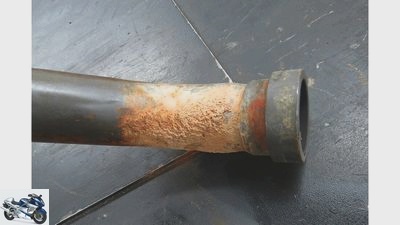
Cook
21/21
The burnt-in clay on the manifold also dissolved.
counselor
workshop
Restoration of the BMW R 80 G / S, part 1 engine
Restoration of the BMW R 80 G / S
Part 1, engine
Content of
Yamaha, Honda, Suzuki, two- and four-stroke engines – at some point you are through with the Japanese classics. And because the next item is not intended for the living room, but for everyday riding, the Bavarian boxer enduro BMW R 80 G / S comes in at just the right time.
Werner Koch
08/28/2014
The good news first: It’s working. Velvety soft, with an impeccable chassis and really amazing qualities. A classic for every day that makes you even more cheerful with every kilometer. Also because you can rely on the cow, because it doesn’t bitch, rushes reliably through the Alps on a short holiday, starts with the first spark and the classic fans get wet eyes at the meeting point. A dream. At least now, when she pretends to be completely normal in the fresh paintwork for a BMW R 80 G / S with 114,000 kilometers on the clock. But the boxer adventure had its price.
Buy complete article

Restoration of the BMW R 80 G / S
Part 1, engine
6 pages) as PDF
€ 2.00
Buy now
Two of them, with original luggage cases, Harro tank bag and handlebar trim, cash on hand. Less than 24 hours later, the cow carcass was dismantled and boned in the workshop. The boxer of the BMW R 80 G / S had purred deceptively lively during the test drive. But as the saying goes: the engine runs best just before it explodes. And that wouldn’t have taken long, as the complete dismantling should show. Given the actual general condition of my cow in November 2013, every vet would have pityingly recommended euthanasia.

workshop
Restoration of the BMW R 80 G / S
Part 2, drive
read more

workshop
Restoration of the BMW R 80 G / S
Part 3 structure, carburetor, electrics
read more
Rust and verdigris on every nook and cranny
Of course, with every renovation the question arises: for what? The BMW R 80 G / S would certainly have dragged itself through for a few hundred kilometers a year or for a show at the annual boxer meeting. Oil consumption in a mixing ratio of one to fifty, paired with sluggish performance and a loud, rickety mechanism – no thanks. For me, the cow is not only a beloved pet, but also a workhorse. Fully packed into the Alps, on gravel roads across the Swabian Alb and every day through the traffic jam city of Stuttgart. And that is only possible if the technology from the starter to the ignition is in solid condition. However, the age-related patina should not be freshly plastered everywhere. Slightly tarnished carburetor housings or slightly weathered fork tubes can stay that way.
The second fundamental question: Should it be a restoration made to the original, or can the BMW R 80 G / S also be trimmed individually? Clear answer: both and. This means that all original parts are retained or completely replaced. This ensures that the G / S can later be dismantled to the original, while at the same time there are no limits to the play instinct. There are enough beautiful ideas and templates for a chic boxer. From the long-legged Herbert Schek enduros to the classic off-road machines of Sebastian Nachtmann, this G / S will also find its way.

Enduro
BMW R 80 G / S against Honda XLV 750 R – the giants exchange blows
BMW R 80 G / S and Honda XLV 750 R in comparison
read more

Enduro
Spotlight: BMW R 80 G / S
30 years of the BMW R 80 G / S
read more

Cook
The cables to the electric starter run through rubber grommets, which are cracked and brittle and immediately put on the shopping list. Pay attention to the original routing and position here as well.
When restoring the BMW R 80 G / S, however, the electrical wiring should be laid as original as possible. The best reminder: a digital photo with which all plug connections and connections are recorded during dismantling. Especially the cable lugs attached to the alternator can easily be mixed up, which can lead to a bad cable fire. All ailing plug connections that are covered with verdigris and a powdery white layer of corrosion in our project should also be photographed and included in the spare parts list. The same applies to all trains and lines.
The BMW engine was new territory for me. I have no idea what goes into the rushes when you drive the BMW R 80 G / S through the years without grooming and patting. Grown up and rooted with the Japanese, only occasionally briefly talking about European motorcycles, you don’t think of anything. You open the tool box, curiously get going – and get stuck. Nothing works here without a puller. Cardan shaft out: only with puller. Gear cover down: only with puller. Camshaft out: only with a puller.
The right tool is needed for everything and every little thing: puller, special tool, gas flame for loosening, gas flame for shrinking on, counter holder here, counter holder there, and a powerful press should also not be missing. Was that great with the Japanese. The alternator rotor was pressed with a self-turned mandrel, a simple counter holder welded together for the clutch and the manageable range of special tools was ready. With the BMW R 80 G / S, on the other hand, you become a toolmaker – in the truest sense of the word. It doesn’t matter, that’s the way it is with old German mechanical engineering.
The pleasure of screwing
On the other hand, the sweeping boxer of the BMW R 80 G / S inspires the pleasure of screwing like no other motorcycle. Hush, valve cover down, six nuts loosened, and the cylinders are already on the workbench. The piston crowns are covered with a thick layer of carbon and burn marks over the entire piston skirt show where the engine oil and performance are evaporating. The Nikasil cylinders almost as new and with hardly any measurable wear force you to consider only equipping the engine with new pistons and rings. After a short calculation, however, this step is discarded and a set of power kit cylinders is ordered from boxer specialist Jochen Siebenrock instead.
To assemble the pistons, the rings must be held together with a tension band and threaded into the cylinder that has not yet been assembled. Anyone who thinks they can squeeze the bulky piston rings into the cylinder with a wooden stick and fingernails will be amazed. That might work with a Yamaha SR 500 piston, but not with the boxer. The 150 gram lighter pistons of the 980 cm³ set with 94 millimeters in diameter add ten horsepower to the BMW R 80 G / S and – very importantly – fill the torque hole in the middle. Which also fixes the number one oil leak.
Will that last??
Oil leak number two is found in the cylinder head of the BMW R 80 G / S. You don’t even have to use the dial gauge for the worn out valve guides, the much too large tilting movement is obvious. Since BMW does without the usual valve stem seal, the engine oil smuggles through the intake valves into the combustion chamber. A case for the specialist workshop, especially since it corrects down the running clearance that is already too large as standard. In order to nail it with heads, valves and seat rings in lead-free quality are replaced at the same time. All valves are deburred and polished on the lathe at the transition from seat to plate. In fact, the old valves could have been grinded and reused. But there is no need for a valve disc that has been torn off due to material fatigue and rammed into the piston crown.
On one of the four needle-bearing rocker arms, a contact surface with a slight pitting to the valve is discovered and pulled off with the oil stone. Will that last? According to the experience of some boxer specialists, in any case, we’ll find out. Especially since the dismantling is done in a few minutes. The bearing shells in the connecting rod feet of the BMW R 80 G / S held up surprisingly well over 114,000 kilometers. Nevertheless, the bearing shells marked with a basic dimension mark will be replaced.
The camshaft timing chain including the slide rail renewed
The main bearings of the BMW R 80 G / S are even better and therefore left in the original, but they can only be examined if the front engine cover and the chain pinion are removed with a puller and by heating. The repair manual by Helmut Heusler (Bodensteiner-Verlag, Boxer-Technik, Volume 3) is now an invaluable guide. Thanks, the man knows. When completing the substructure, the camshaft timing chain and slide rail are also replaced. A process that can only be accomplished with skillful fingers and a trick that emerged from necessity.
Oil leak number three on the BMW R 80 G / S is drained by replacing all Simmerrings. The assembly of the large sealing ring between the crankshaft bearing and the clutch requires a very special technique. Due to a shoulder on the crankshaft stub, the sealing lip does not slip into its intended position. A thin cardboard box wrapped in packing tape serves as a provisional but functional assembly aid, which can be used as a guide and “climbing aid” to enable assembly without special BMW tools.
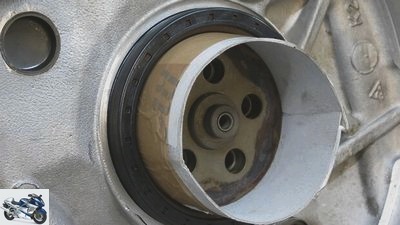
Cook
The large oil seal on the crankshaft must be lifted over the shoulder on the crankshaft stub with a thin sleeve, in this case a temporary construction made of cardboard and adhesive tape.
The optical preparation of the ugly discolored engine housing of the BMW R 80 G / S was done by glass bead blasting. It must be clear that afterwards a meticulous, complete dismantling is due. The fine granulate can be found in every corner, in every sealing gap and in every thread. A huge mess that can only be eliminated by rinsing and blowing out thoroughly several times with compressed air. Alternatives? So far, none, although the editors are happy to be taught better by the experience of the readers.
The surface of the sheet steel covers and sealing plugs, which is roughened during glass bead blasting, is protected from corrosion with clear varnish, after which the renovated engine can be planted in the freshly rebuilt chassis. A nice moment when the boxer project moves forward. So stay tuned when the next MOTORRAD Classic issue (8/2014) is about getting the gearbox, clutch and cardan drive of the BMW R 80 G / S up to scratch.
Trying out: ice blasting device
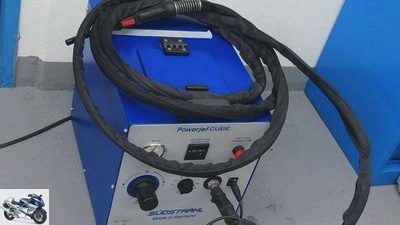
Cook
Compact ice blasting device with hose package that is filled with dry ice granulate.
As part of the complete restoration, MOTORRAD Classic tried out a compact ice blasting device that weighed only 30 kilograms. In contrast to sandblasting, the treated surface is not removed. The dry ice used, a CO2 gas cooled to 78 degrees, is fed as granules to the air pressure nozzle, which operates at up to 12 bar, loosens the dirt particles from the surface and evaporates without leaving any residue.
For example, drum brakes or motor housings can be cleaned without damaging the steel brake ring or the Simmerrings. This means that components such as exhaust systems can also be cleaned when they are installed. However, the required dry ice only lasts for a few days in the cool box. More information about the device, which costs 5980 euros, is available at www.suedstrahl.de
Related articles
-
Restoration of the BMW R 80 G-S, part 6 – overview of costs and effort
Cook 9 pictures Cook 1/9 The good news first: It’s working. Velvety soft, with an impeccable chassis and really amazing qualities. A classic for every…
-
Restoration of the BMW R 80 G-S, part 3 structure, carburetor, electrics
Photo: Koch 10 pictures Cook 1/10 There are reasons why the R 80 G / S is back in the workshop after just a few hours. More about this in the MOTORRAD…
-
Restoration of the BMW R 80 G-S part 4 engine and carburetor adjustment
Cook 23 pictures Cook 1/23 Small and big changes make the almost 70 hp of the renovated R 80 G / S. Cook 2/23 The new, original air filter sits on this…
-
Restoration of the BMW R 80 G-S, part 5 chassis and brakes
Cook 19th pictures Cook 1/19 Cook 2/19 On the left the new, on the right the plate-shaped, warped coupling base plate. Cook 3/19 Clutch removal, act…
-
Restoration of the BMW R 80 G-S
Cook counselor workshop Restoration of the BMW R 80 G / S Restoration of the BMW R 80 G / S 160 working hours at a glance Content of All parts of the…
-
Restoration of the BMW R 80 G-S
fact 17th pictures Cook 1/17 Single-arm swing arm with the 50 millimeter long aluminum milled part between the flange (arrow). Due to the longer lever…
-
New 500cc two-stroke Bimota engine
counselor technology & future New 500cc two-stroke Bimota engine New 500cc two-stroke Bimota engine Easy sense While the Japanese are turning their back…
-
Technology: engine technology super sports car
fact 23 pictures fact 1/23 The Honda Fireblade has been a great performer for twenty years. PS takes a close look at the development of engine…
-
Technology: BMW S 1000 RR engine in detail
BMW 13th pictures Artist 1/13 The on-board tool kit of the BMW almost ties in with old traditions. With the help of the nine-part set you can strip the…
-
Energica Eva Ribelle RS: New engine, new driving pleasure
News 2022 New motorcycle items for 2022 Markus Jahn 11 pictures Markus Jahn 1/11 The new EMCE engine from Energica drives the three well-known models…